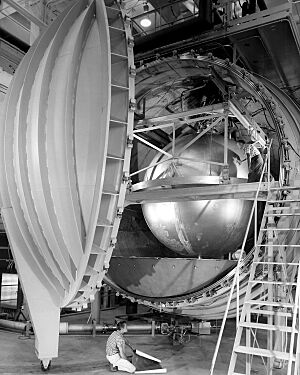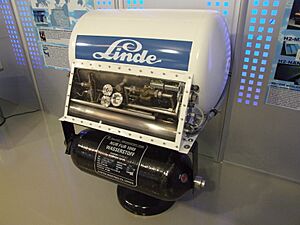Liquid hydrogen facts for kids
Liquid hydrogen (H2(l)) is simply hydrogen in its liquid state. Hydrogen is a very common element found naturally as a molecule called H2. It's a colorless liquid that looks like water, but it's incredibly cold!
To turn hydrogen gas into a liquid, it needs to be cooled down a lot. It must be colder than -239.9 °C (33 Kelvins). To be fully liquid at normal air pressure, it needs to be cooled even more, to about -252.87 °C (20.28 K). This extreme cooling process often uses special machines that work a bit like jet engines.
Liquid hydrogen is a great way to store hydrogen because it takes up much less space than hydrogen gas. However, it's not very dense compared to other fuels. Once it's liquid, it can be kept that way for some time in special containers that are super insulated, like a very advanced thermos.
There are two types of hydrogen molecules based on how their tiny parts (called spins) are arranged. At room temperature, hydrogen is mostly one type. But when it's made into liquid hydrogen, it becomes almost entirely the other type, called parahydrogen.
Contents
Making Liquid Hydrogen
Turning hydrogen into a liquid takes a lot of energy. Even with the best methods, it uses about 10 to 13 kilowatt-hours of energy for every kilogram of hydrogen. This is a lot, especially when you compare it to the energy you get from burning that same amount of hydrogen, which is about 33 kilowatt-hours.
History of Liquid Hydrogen

Scientists have been studying hydrogen for a long time. In 1885, a scientist named Zygmunt Florenty Wróblewski figured out the exact temperatures and pressures needed for hydrogen to become a liquid.
Then, in 1898, James Dewar successfully turned hydrogen into a liquid. He used a special cooling method and his own invention, the vacuum flask, which is like the insulated bottles we use today. Later, in 1929, scientists Paul Harteck and Karl Friedrich Bonhoeffer were the first to create the stable form of liquid hydrogen, called parahydrogen.
Spin Types of Hydrogen Molecules
Hydrogen molecules (H2) have two tiny parts inside their center, called nuclear spins. These spins can be arranged in two different ways.
- Parahydrogen: In this type, the two spins point in opposite directions. This arrangement is more stable.
- Orthohydrogen: In this type, the two spins point in the same direction. This arrangement is less stable.
At room temperature, hydrogen gas is mostly orthohydrogen. But when hydrogen is cooled down to become a liquid, it slowly changes into the more stable parahydrogen. This change releases heat, which can make some of the liquid hydrogen boil away. To prevent this, special materials called catalysts are used during production. These catalysts help the hydrogen quickly change into parahydrogen, making it safer for long-term storage.
Uses of Liquid Hydrogen
Liquid hydrogen is a very important liquid fuel for rockets. Space agencies like NASA and the United States Air Force use it to launch spacecraft. They have huge tanks that can hold millions of liters of liquid hydrogen.
In most rocket engines, liquid hydrogen first helps cool the engine parts. Then, it mixes with an oxidizer, usually liquid oxygen, and burns. This burning creates water vapor and a lot of power to push the rocket into space. Rocket engines often use a bit more hydrogen than oxygen. This helps protect the engine and makes the rocket go faster, even if it means not all the hydrogen burns.
Liquid hydrogen can also power engines in cars or fuel cells. Some submarines and special concept cars, like the BMW H2R, have been built using liquid hydrogen. Because it's similar to liquefied natural gas (LNG), some equipment can be shared between them. Scientists are also looking into using liquid hydrogen as a zero-carbon fuel for airplanes, meaning it wouldn't produce harmful emissions.
Besides fuel, liquid hydrogen is used in science. It helps cool down tiny particles called neutrons for experiments. It was also used in special scientific tools called bubble chambers to study very small particles. The first thermonuclear bomb, called Ivy Mike, used liquid deuterium (a heavier type of hydrogen) for its powerful reaction.
Properties of Liquid Hydrogen
When hydrogen burns in pure oxygen, the only thing it creates is water vapor. This is why it's often called a "zero-emission" fuel. However, if it burns in air, the high temperatures can create some harmful gases.
Liquid hydrogen has a very low density, only about 70.85 kilograms per cubic meter. This means it's very light for its size. Even though it has more energy per kilogram than gasoline, its low density means you need a very large tank to store the same amount of energy as other fuels.
Because it's so cold, liquid hydrogen needs special storage. It requires containers with excellent insulation, similar to those used for liquid oxygen. Even with these special containers, it's hard to keep it cold enough, and a small amount of hydrogen will slowly evaporate each day.
The melting point of liquid hydrogen is about -259.14 °C, and its boiling point is about -252.87 °C.
Safety with Liquid Hydrogen
Working with liquid hydrogen requires careful handling because it is extremely cold. Touching it can cause severe cold burns.
Hydrogen gas itself is not harmful to breathe, but if it replaces too much oxygen in the air, it can cause asphyxiation. The biggest safety concern with hydrogen is that it is highly flammable. It can easily catch fire or even explode when mixed with air.
Unlike hydrogen gas at normal temperatures, which floats up because it's lighter than air, hydrogen that has just evaporated from its liquid form is very cold. This makes it heavier than air, so it can stay close to the ground and form dangerous, flammable mixtures with air. Therefore, liquid hydrogen must always be kept far away from heat or flames unless it's meant to be burned.
See also
- Industrial gas
- Liquefaction of gases
- Hydrogen safety
- Compressed hydrogen
- Cryo-adsorption
- Expansion ratio
- Gasoline gallon equivalent
- Slush hydrogen
- Solid hydrogen
- Metallic hydrogen
- Hydrogen infrastructure
- Hydrogen-powered aircraft
- Liquid hydrogen tank car
- Liquid hydrogen tanktainer
- Hydrogen tanker




